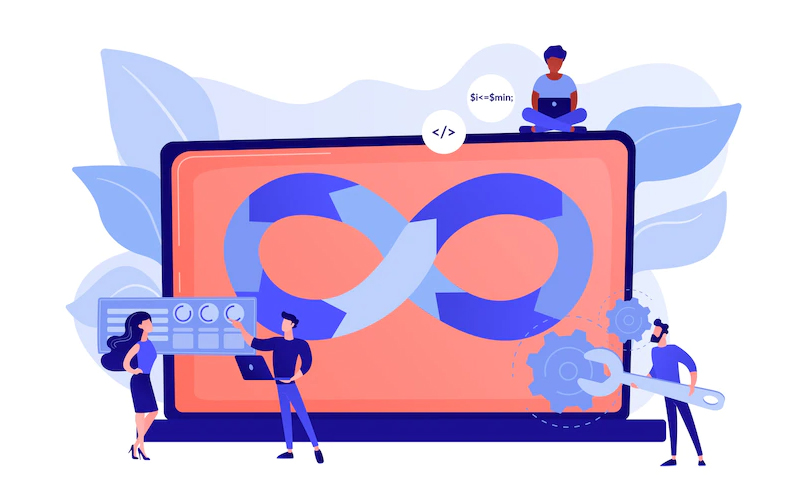What is DevOps? Is it a movement? A new process or technology?
DevOps is a combination of software development and operations. It is blended to focus more on communication, collaboration, and cohesion between the developer and IT operations teams. It is heavily inclined towards establishing collaborative culture and improving efficiency through automation with DevOps tools. After all, it takes a combination of both culture and tools to be successful. Overall, it enables continuous delivery of value to the end users.
DevOps is an extension of Agile that is characterized by increased collaboration, decreasing silos, shared responsibility, autonomous teams, valuing feedback, and increasing automation. Prior to DevOps, progress was measured in terms of working software, while with DevOps, it is measured in terms of working software in customer’s hands. The tools include configuration management, test and build systems, application deployment, version control and monitoring tools. Overall, DevOps is all about delivering more and a higher quality of IT innovation to the end user quite faster.
There is no specific way to implement and gain experience with DevOps. You just need to find a way to tie your DevOps team to a business benefit. Being open minded about the types of projects will enable you to stay focused on supporting your DevOps team and analyzing how it can work well for you. Below are some points about what people often expect:
Release on Demand
Let us get familiar with release on demand. It is the process that allows the features deployed into production to be released immediately or incrementally to the customers based on market demand. It is considered a critical aspect of a continuous delivery pipeline.
Releasing provides the data required to decide whether further exploration of an idea is warranted or if new functionality should be added. Implementation of automation on release management allows the organization to:
- Release when they like
- Be predictable, quick and consistent
- In the event of failure, organizations can roll back rapidly to the last known good state
- Deliver a full audit trail for compliance purposes
- Avoid having any release weekends
Get Rid of Technical Debt
Technical debt involves the eventful consequences of poor software or the infrastructure choices within the organization. It is often better to identify the technical debt and fix it so that your code can make money for you. However, when unplanned work triggers technical debt, it is high time to prioritize it so that it stops being unplanned. Technical debt and unplanned work are very important for DevOps. It really understands that the development decisions, which do not consider operational concerns often, result in unplanned work. If testing is done earlier in the cycle, it will ensure quicker and easy to fix defects.
Avoid Blame and Failure
Failure at some point is inevitable. It is considered a waste of money that can damage your career and deflate the morale. If given the right mind-set and culture, these failures can lead to improvement within the organization.
Sadly, it is general trend within many organizations to focus on blame. “Why would I voluntarily admit a fault or put my reputation on stake”. Companies on a whole need to focus on “What happened and what can I do to fix it?” rather than “Who did it?” Thus, it depicts the culture of not taking the risks, inflexibility and lack of employee engagement.
However, DevOps culture creates an environment where people feel empowered and safe to innovate. They are not often afraid of trying new things. It involves various processes and tasks that remove certain risks associated with failure, such as:
- Provides early warning signs for failure
- Ability to instantly redeploy the last known good state
- Templating the deployments
- Automated testing
Think about End-users
Organizations need to move away from a network centric approach and strive to measure the level of application performance as measured by the end users. More than testing, an organization can measure the impact of a new feature and the way end users would like it. DevOps is highly aimed at understanding more about the end user, thereby optimizing the innovation for success and better investment decision.
Target End User Specific Features
It is important that features are specified by end users and the target business. The value of a feature can be expressed as a straightforward relationship between perceived benefits and perceived costs. From the first time the customers land on your website to when they become the regular users, they are always weighing on whether the software’s benefits are worth its cost or not. It is important that you integrate the software manufacturing pipeline and have an effective application monitoring tool to identify the changes at the business transaction level.
Undeniably, the shift from waterfall to agile has transformed the development model, allowing end users access to changes much faster. This in turn allows customer feedback to drive the design and prioritization of new features.
Summary
Kickstart Your Project With Us!
Blog
Popular Posts
CONTACT US
Let's Build Your Agile Team.
Experience Netsmartz for 40 hours - No Cost, No Obligation.
Connect With Us Today!
Please fill out the form or send us an email to
 Don't Miss Out:
Don't Miss Out: 









